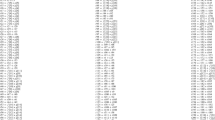Abstract
One of the most cost-critical operations when applying Shor’s algorithm to binary elliptic curves is the underlying field arithmetic. Here, we consider binary fields \({\mathbb {F}}_{2^n}\) in polynomial basis representation, targeting especially field sizes as used in elliptic curve cryptography. Building on Karatsuba’s algorithm, our software implementation automatically synthesizes a multiplication circuit with the number of \(T\)-gates being bounded by \(7\cdot n^{\log _2(3)}\) for any given reduction polynomial of degree \(n=2^N\). If an irreducible trinomial of degree \(n\) exists, then a multiplication circuit with a total gate count of \({\mathcal {O}}(n^{\log _2(3)})\) is available.


Similar content being viewed by others
Notes
As usual, by a \(T\) -gate we mean the matrix \(\left( \begin{array}{cc}1&{}0\\ 0&{}\hbox {e}^{i\pi /4}\end{array}\right) \), and for the resource analysis we do not distinguish between \(T\)- and \(T^\dagger \)-gates.
The somewhat unusual indexing will become clear in a moment.
Performing the same multiplication with constant \(T\)-depth would be possible, the trade-off being additional wires—our Sage implementation can be adapted to optimize the number of qubits for a given constraint on the \(T\)-depth.
The processing of \(X\) and \(Y\) is identical up to relabeling, so the length of \(L\) is half of the total number of CNOT gates.
References
Amento, B., Rötteler, M., Steinwandt, R.: Efficient quantum circuits for binary elliptic curve arithmetic: reducing \(T\)-gate complexity. Quantum. Inf. Comput. 13, 631–644 (2013)
Amento, B., Rötteler, M., Steinwandt, R.: Quantum binary field inversion: improved circuit depth via choice of basis representation. Quantum. Inf. Comput. 13, 116–134 (2013)
Amy, M., Maslov, D., Mosca, M., Roetteler, M.: A Meet-in-the-Middle Algorithm for Fast Synthesis of Depth-Optimal Quantum Circuits. Computer-Aided Design of Integrated Circuits and Systems, IEEE Transactions on 32(6), 818–830 (2013). For a preprint version see [4]
Amy, M., Maslov, D., Mosca, M., Roetteler, M.: A meet-in-the-middle algorithm for fast synthesis of depth-optimal quantum circuits arXiv:quant-ph/1206.0758v3, (January 2013). Available at http://arxiv.org/abs/1206.0758v3
Budhathoki, P., Steinwandt, R.: Automatic synthesis of quantum circuits for point addition on ordinary binary elliptic curves. Quantum Information Processing, (accepted, to appear). Preprint http://lanl.arxiv.org/abs/1401.2437v1
Burns, M.: QCViewer. GitHub repository, June 2013. Available at https://github.com/aparent/QCViewer
Childs, A.M., van Dam, W.: Quantum algorithms for algebraic problems. Rev. Mod. Phys. 82(1), 1–52 (2010)
Fan, H., Hasan, A.: Alternative to the Karatsuba algorithm for software implementations of \(GF(2^n)\) multiplications. IET Inf. Secur. 3(2), 60–65 (2009)
von zur Gathen, J., Gerhard, J.: Polynomial factorization over \({\mathbb{F}}_{2}\). Math. Comput. 71(240), 1677–1698 (2002)
Karatsuba, A.A.: The complexity of computations. In: Proceedings of the Steklov Institute of Mathematics, 211:169–183, 1995. Available at http://www.ccas.ru/personal/karatsuba/divcen.pdf. Translated from Trudy Matematicheskogo Instituta imeni V.A. Steklova, Vol. 211, (1995) pp. 186–202
Kowada, L.A.B., Portugal, R., de Figueiredo, C.H.M.: Reversible Karatsuba’s algorithm. J. Univ. Comput. Sci. 12(5), 499–511 (2006)
Maslov, D.: Reversible Logic Synthesis Benchmarks Page. http://webhome.cs.uvic.ca/~dmaslov/, (2011)
Maslov, D., Falconer, S.M., Mosca, M.: Quantum circuit placement: optimizing qubit-to-qubit interactions through mapping quantum circuits into a physical experiment. In: Proceedings of the 44th Design Automation Conference—DAC 2007, pp. 962–965. ACM, (2007)
Maslov, D., Mathew, J., Cheung, D., Pradhan, D.K.: An \(O(m^2)\)-depth quantum algorithm for the elliptic curve discrete logarithm problem over GF\((2^m)\). Quantum Inf. Comput. 9(7), 610–621 (2009). For a preprint version see [15]
Maslov, D., Mathew, J., Cheung, D., Pradhan, D.K.: On the Design and Optimization of a Quantum Polynomial-Time Attack on Elliptic Curve Cryptography. arXiv:0710.1093v2, (2009). Available at http://arxiv.org/abs/0710.1093v2
Menezes, A.J., van Oorschot, P.C., Vanstone, S.A.: Handbook of Applied Cryptography. CRC Press, (2001). Sample chapters http://cacr.uwaterloo.ca/hac/
National Institute of Standards and Technology, Gaithersburg, MD 20899–8900. FIPS PUB 186–4. Federal Information Processing Standard Publication. Digital Signature Standard (DSS), (July 2013). Available at http://nvlpubs.nist.gov/nistpubs/FIPS/NIST.FIPS.186-4.pdf
Offermann, S., Wille, R., Dueck, G.W., Drechsler, R.: Synthesizing multiplier in reversible logic. In: 13th IEEE Symposium on Design and Diagnostics of Electronic Circuits and Systems—DDECS 2010, pp. 335–340. IEEE Computer Society, (2010)
Parent, A.: Quantum Arithmetic Circuit Generator. GitHub Repository, (2012). Avalable at https://github.com/aparent/qacg
Rötteler, M., Steinwandt, R.: A quantum circuit to find discrete logarithms on ordinary binary elliptic curves in depth O\((\log ^2 n)\). Quantum Inf. Comput. 14(9–10), 888–900 (2014). http://dl.acm.org/citation.cfm?id=2638681
Shor, Peter W.: Polynomial-time algorithms for prime factorization and discrete logarithms on a quantum computer. SIAM J. Comput. 26(5), 1484–1509 (1997)
Stein, W.A. et al.: Sage Mathematics Software (Version 5.4). The Sage Development Team, (2012). http://www.sagemath.org
Acknowledgments
The authors thank Richard Cleve, Stephen Locke, and Dmitri Maslov for helpful discussions, and an anonymous referee for making us aware of [19]. RS is supported by NATO’s Public Diplomacy Division in the framework of “Science for Peace,” Project MD.SFPP 984520.
Author information
Authors and Affiliations
Corresponding author
Rights and permissions
About this article
Cite this article
Kepley, S., Steinwandt, R. Quantum circuits for \({\mathbb {F}}_{2^{n}}\)-multiplication with subquadratic gate count. Quantum Inf Process 14, 2373–2386 (2015). https://doi.org/10.1007/s11128-015-0993-1
Received:
Accepted:
Published:
Issue Date:
DOI: https://doi.org/10.1007/s11128-015-0993-1




